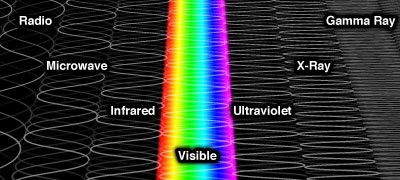|
 |
 |
|
|
Sky Crystal
A rainbow is both an excellent and naturally occurring illustration of the crystal effect on the visible spectrum. This is because a rainbow is actually billions of tiny water particles all possessing similar molecular structures and thus similar refractive properties to crystal.
After a summer shower, when conditions afford both a high concentration of large water particles in the atmosphere as well as ample sunlight [that's to say full spectrum white light], the water refracts the light, dividing by its separate wavelengths and consistently displays them in perfect sequential order. That is the phenomena we're witnessing when we look at a rainbow.
We say that it is consistent because the order is always the same, it has to be. The order is defined by the lengths of the EM waves, and we perceive each length as but one specific colour. It always begins with the longest EM wave lengths that our eyes can detect. When the EM waves cross out of the infraRed band we become aware of the energy, perceiving it as red light. As the wave lengths shorten we perceive them as oranges, then yellows, greens, blues and finally the shortest that we can see, violets. After that the EM energy is ultraviolet and its waves are too short to stimulate our eyes, rendering them invisible to us.
|
|